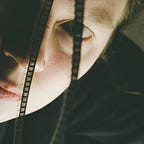In Our Care, Part 2
This is the second post of a two-part series I wrote while working as a Digitization Technician at the Digital Production Unit of the Oregon State University Special Collections & Archives Research Center (OSU SCARC). This post was originally posted on October 29, 2018, on the SCARC blog. Content has been modified here.
Every year on October 27th, archives worldwide join together to celebrate the World Day for Audiovisual Heritage to raise awareness of the importance of audiovisual archives and their vulnerability, as well as to acknowledge the work of individuals and institutions that protect it. To honor this day, we share the second part of the “In Our Care” KOAC-TV Films preservation project.
Be kind, rewind
Inspecting a film on the rewinder.
In the previous blog post about the first part of this project, I went through the film’s inspection process and findings, and today I will address their cleaning, repairing, and rehousing.
Cleaning, repairing and rehousing the “In Our Care” KOAC-TV films
For cleaning, repairing, and rehousing the films I used the following elements:
- 16mm film projector;
- Splicer and splicing tape;
- Anti-static brushes;
- Blank leader;
- Cores;
- Polypropylene film cans.
1. Rewinding, cleaning, and transferring to cores:
Having a 16mm film projector at the Library, I used it to automatically rewind each of 35 films. This allowed me to dry-clean the films using two anti-static brushes (as shown below) while they were rewinding.
Cleaning a film while rewinding.
At this point, the films that had been stored on projection reels were transferred to cores.
Before and after of a film originally stored on a projection reel and transferred to a core.
2. Repairing and preparing for rehousing:
After I had the films cleaned, I removed old tape residues, repaired broken perforations, and replaced old splices with new ones. In addition to this, I also added blank leader at the head/tail of films, for their protection, and replaced leaders showing decay signs for new ones in order to prevent any damage or contamination on the films. I transferred all information written on the old leaders to the new ones.
Yellowed leader, affected by oxide residues, vs. a new one; the attachment of the new leader to the film with the splicer.
Some films were loosely wound up and showed signs of “spoking”, that is, a particular curl caused by the storage environment relative humidity and by acetate base decay; to prevent further deformation, I tightened the films up.
A film reel showing signs of “spoking”; the same film reel once transferred to a core and tightly wound up.
3. Rehousing:
Finally, I rehoused the films ––which had come originally in metal cans, some of them severely rusty–– to polypropylene ones. I housed one film per can, on cans appropriate to the size of each film.
Some original metal cans piled up; the same pile of films once rehoused to polypropylene cans.
Documentation:
I documented my findings on a spreadsheet in the cloud. I also made photographic records of the elements using my cellphone, some of which I am using for this article.
Box/Item/Title/Originally had leader/Leader was added/Originally on core/Transferred to core/Cleaned/Repaired/Rehoused/Notes
For more information on audiovisual preservation please refer to UNESCO’s “Recommendation for the Safeguarding and Preservation of Moving Images”, available in English, Spanish, and French.
